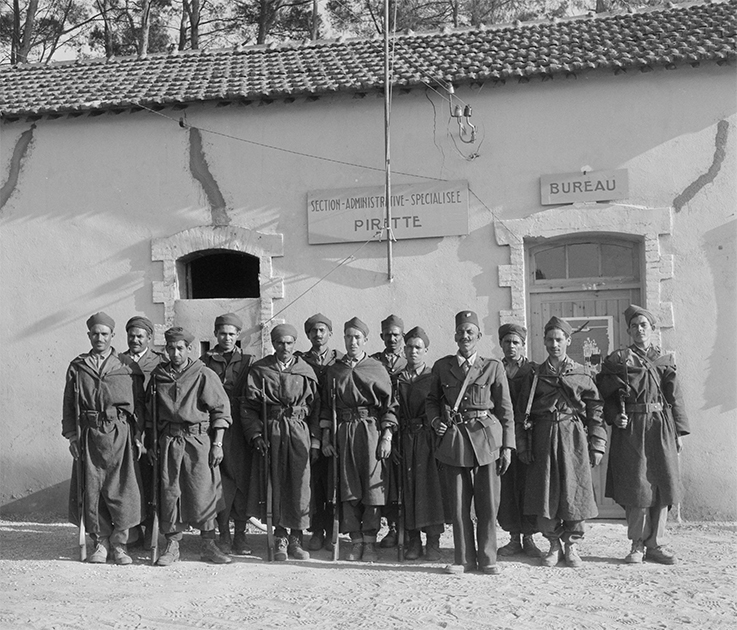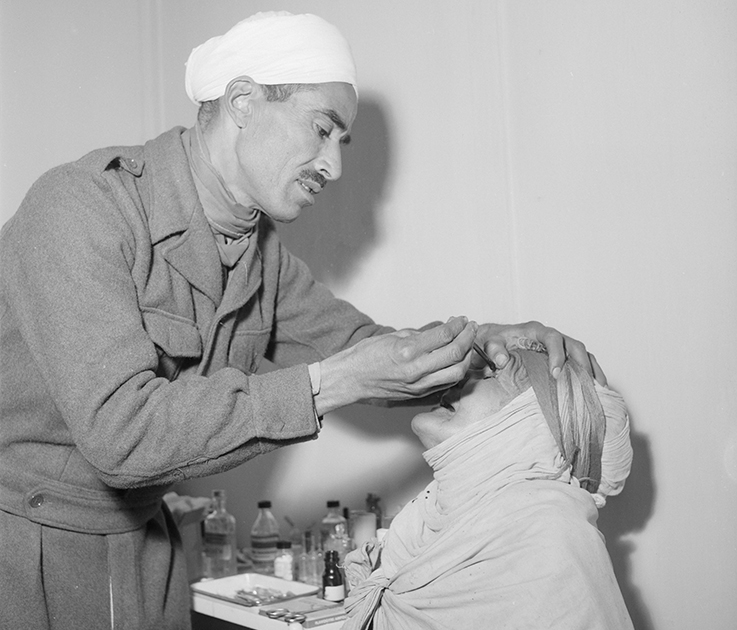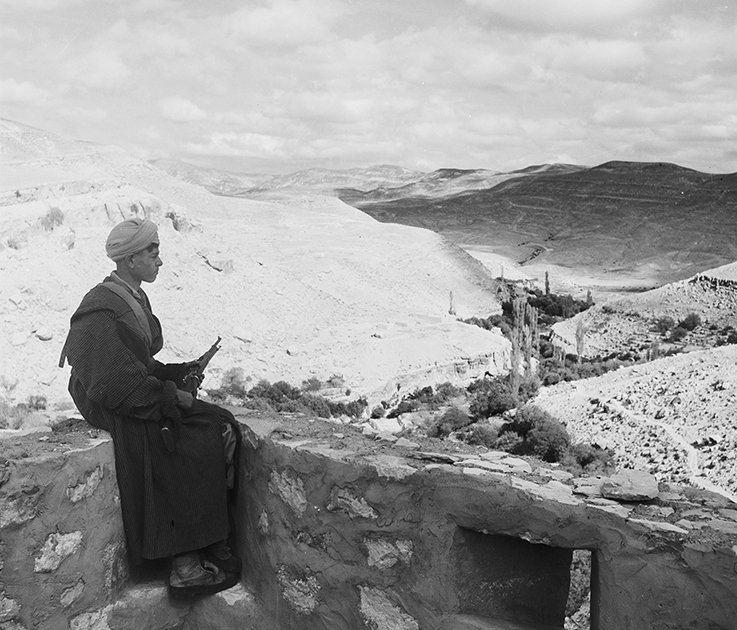The SASs in Algeria: the military coming to the people’s aid

“Lieutenant Yvon Durand, who led his harkis as far as Ongles in the Provençal Alps (...). I address France’s salute to these lucid, loyal men. They had the generosity of spirit and goodness of heart our country was in need of at that time.”
Emmanuel Macron, “Speech in memory of the harkis”, 20 September 2021

ALG 56-114 R30: Maghzens in Pirette. © Berger/ECPAD/Défense
{"preview_thumbnail":"/sites/default/files/styles/video_embed_wysiwyg_preview/public/video_thumbnails/9tVGAksr55g.jpg?itok=XffEtN6N","video_url":"https://youtu.be/9tVGAksr55g","settings":{"responsive":1,"width":"854","height":"480","autoplay":1},"settings_summary":["Embedded Video (Adaptatif, autoplaying)."]}
Yvon Durand, to whom French President Emmanuel Macron paid tribute on 20 September 2021, was the head of a Specialised Administrative Section (SAS) during the Algerian War. Often neglected, the SASs were at the heart of French policy for Algerian integration, which was sought under the Fourth and Fifth Republics. In 1960, 700 SASs were deployed across Algeria to build infrastructure, govern the villages, provide health care for the population and schooling for the children, and restore order.
They were the brainchild of the Governor-General of Algeria, Jacques Soustelle. In 1955, he was quick to acknowledge the lack of governance in rural areas, the absence of intelligence and the failure of the major military operations against the ALN. After running a pilot operation in the region of Aurès, led by General Parlange, Soustelle decided to set up the Special Administrative Sections. His background as an ethnologist in Mexico had shown him the importance of getting to know the population. Having observed the indigenist policies implemented by the Mexican government to provide schooling and health care for the Indians, he wanted to do the same in Algeria. Finally, his experience at the BCRA, Free France’s intelligence bureau, showed him how crucial intelligence was to the success of a military operation. The activities of the SASs in Algeria were in the tradition of Marshal Lyautey’s indigenous affairs service in Morocco, in which General Parlange had served.
An SAS was both a civilian and a military administrative body. It was run by a regular officer, conscript or reservist on active service. Durand belonged to the latter category: an ethnologist and reserve officer in the 13th Airborne Dragoons, he was an intelligence officer for his regiment in 1957. On his return to civilian life, in 1959 he decided to volunteer with the Specialised Administrative Sections, as a reserve officer on active service[1].
An SAS officer commanded a maghzen comprising around 30 moghaznis (auxiliaries) tasked with ensuring his protection and the security of the SAS district. He had one conscripted officer or regular NCO to assist him, together with a number of civilian staff (an accountant, a radio operator, a nurse). In addition, a doctor, primary school teacher and sports instructor were seconded by the military company located closest to the SAS. In practice, the civilian and military staff of the Specialised Administrative Sections varied according to the needs of the population, the size of the territory (some were as big as a department) and the degree of isolation and security of the sector. An SAS was responsible for a rural or urban area (shanty town) with anywhere from 2000 to 20 000 inhabitants, either dispersed in villages or living in a single relocation camp.

ALG 57-126 R44: Post providing free medical care at the SAS of Flatters. © Georges Petit/ECPAD/Défense
Durand was appointed head of the SAS of Thiers, in the Palestro area of Kabylia. To raise the standard of living of farmers in his district, he set up an agricultural cooperative, which bought their produce at market price, not at the low prices paid by merchants in Palestro. He had abandoned land planted with crops and protected by his maghzen to prevent them from being ravaged by militants of the FLN (National Liberation Front) and its armed wing, the ALN (National Liberation Army).
If an officer was married, he was permitted to live with his wife and children in the SAS bordj (fort). The officer’s wife would often work as a volunteer in teaching, nursing or supporting the empowerment of Muslim women. Durand himself was married, and his wife ran the women’s community centre, where she gave sewing and childcare classes to help the Algerian women run their households more effectively.
Since his was a very large district, Durand set up new offices closer to the relocated communities: the SASs of Maala El Isseri (with a population of 5 000) and Ouled Gassem. He improved the living conditions of communities relocated for security reasons, using traditional materials (a mixture of mud and straw), well suited to the climate of Kabylia – cool temperatures in winter, blistering heat in summer – unlike the more modern houses built of concrete blocks and corrugated iron, which were wholly inappropriate. He put up all the buildings necessary to the running of a modern commune, such as a town hall, school, infirmary, orphanage and grocery store, providing jobs for the unemployed, better government for the population and improved living standards through schooling and healthcare. The school was run by conscripts of the 1st Marine Infantry Regiment (1st RIMa), who as civilians were primary school teachers; they taught the children to read and write, ran the canteen at lunchtime and organised after-school activities. The actions of Yvon Durand and his wife earned them the respect of the Kabyle people, who were hostile to the French at the beginning of the Algerian War and went on to become loyal to France.
Depending on the level of security, the SASs concerned themselves more with the people or focused on operations to loosen the ALN’s grip. The SAS officer relied on his moghaznis, who “were interpreters, scouts, trackers and warriors, standing guard, holding positions and securing strategic sites, sometimes whole villages or vast areas”[2].
It was also the SAS’s job to gather intelligence. To that end, it set up a network of informers, while the SAS officer talked with residents to get an idea of their state of mind. The moghaznis and civilian staff were often called upon to contribute by gathering information from their contacts among the population. In its day-to-day operations, the SAS came up against the FLN’s Political and Administrative Organisation (OPA), which was also seeking to control the population. It therefore increased the number of operations to dismantle the OPAs, which could vary from a handful of people to a highly organised network.
To combat the ALN, SAS officers sought to rally the support of individuals and sometimes whole groups (like the leaders Bellounis and Si Cherif). While the rallying of groups often ended in failure, individual support for the SASs demonstrated the positive impact of the economic and social actions carried out by SAS officers within the ALN ranks. To counter ALN attacks, the SASs armed some villages as part of self-defence groups.

ALG 57-241 R13: A lookout tower in the Taberdga sector. © Descamps/ECPAD/Défense
The civilian and military operations of the Specialised Administrative Sections prompted reactions from the FLN, with calls to boycott SAS offices, the destruction of identity cards, recommendations to abstain from voting in the elections, assassinations of special representatives and municipal councillors installed by the SASs, pressure on construction workers and consultants of free medical care, threat letters and assassinations of SAS officers, civilian personnel and moghaznis, and attempts to encourage desertions from the maghzen and attacks on the SASs, sympathetic villages and self-defence groups. During the Algerian War, 70 SAS officers and 607 moghaznis were killed in civilian and military operations.
From 1960 onwards, many SAS officers noted a shift in the emphasis of Charles de Gaulle’s policy on Algeria towards self-determination. Reserve officers on active service resigned, while regular officers asked to return to their original units. As for those who remained, following the ceasefire of 19 March 1962, some witnessed ALN reprisals against their moghaznis, as was the case of conscripted SAS officer and future defence minister (1988-91) Jean-Pierre Chevènement: “On 19 March, I witnessed an awful scene. Several of mymoghaznis, together with the chief of the Muslim village of Saint-Denis du Sig [Oranie], were killed in the most horrible way by an FLN commando.”[3].
In April 1962, Yvon Durand resigned from his post as SAS head, in order to better prepare for the repatriation of French Army auxiliaries and their families. With other former SAS officers he founded the Association of Veterans of Algerian Affairs and organised the secret repatriation of 2 500 family members of moghaznis and harkis from the Palestro area who had served on the French side and whose lives were at risk after Algerian independence in 1962[4]. In October 1962, with the support of the mayor of one commune, he resettled 23 families of harkis in Ongles, Haute-Provence. They were given jobs by the forestry office, before going on to settle in Mouans-Sartoux, in Alpes Maritimes. He converted the buildings of Ongles into a pre-vocational training centre for auxiliaries and their children. Durand was killed in a car accident one Sunday morning in 1986, while on his way to help a harki[5].
The experience of the Specialised Administrative Sections in the Algerian War has not been forgotten; in 1995, the French Army set up Civilian and Military Operations (ACM) units, while NATO forces are now equipped with Civil-Military Cooperation (CIMIC). Today, in all theatres of operations, these units support the military by seeking to win acceptance of the force’s presence from the disadvantaged populations of conflict zones and to aid their economic and social development.
Gregor Mathias
An associate researcher in geopolitics at the Rennes School of Business, Gregor Mathias has a PhD in History and is the author of a number of books on the Algerian War, including Les SAS en Algérie, entre idéal et réalité (L’Harmattan, 1997) and La France ciblé. Terrorisme et contre-terrorisme pendant la guerre d’Algérie (Vendémiaire, 2016). He was historical adviser for the CDHA exhibition on the history of the Specialised Administrative Sections: Les sections administratives spécialisées | cdha.fr

